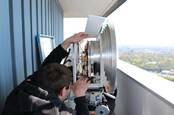This article is more than 1 year old
Boffins build the smallest transistor, controlled by an atom
It has potential, but don't expect anything useful too soon
The world’s smallest transistor can be controlled by a single atom, according to a scientists from the Karlsruhe Institute of Technology in Germany.
Unlike more traditional transistors it isn’t made from semiconductors. Instead, it’s crafted from metal and the gate - the part that acts as a switch turning a transistor on or off - is a blob of electrolyte gel.
“The single‐atom transistor represents a quantum electronic device at room temperature, allowing the switching of an electric current by the controlled and reversible relocation of one single atom within a metallic quantum point contact. So far, the device operates by applying a small voltage to a control electrode or “gate” within the aqueous electrolyte,” according to the paper’s abstract published in Advanced Materials.
The gel connects two small metallic strips containing silver, and when a small electric field is applied it kickstarts the flow of electrons into the electrolyte gel. The gel, made from pyrogenic silicon dioxide, contains a gate that acts as a bridge connecting the gap in between metal strips so that current can flow.
"By an electric control pulse, we position a single silver atom into this gap and close the circuit," said Thomas Schimmel, co-author of the paper and a professor in the Scanning Probe Microscopy and Nanolithography group at KIT. "When the silver atom is removed again, the circuit is interrupted." In this state, the transistor is turned off.
The single-atom transistor can drive a tiny current of somewhere between one to eight microAmps. Since it’s made from metal, it can conduct electricity more efficiently than semiconductors and consumes less power. “This quantum electronics element enables switching energies smaller than those of conventional silicon technologies by a factor of 10,000," said Schimmel.
The advantages may seem promising, but it’s just a prototype for now. It requires millions and billions of these transistors to build anything useful - a cheap USB memory stick already contains several billion transistors. The real challenge to making them applicable in the real world lies in the scaling up the manufacturing process. ®

